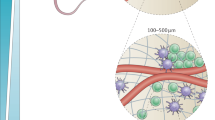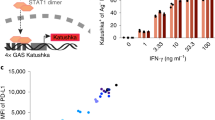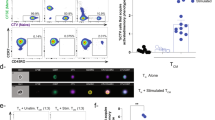Abstract
Naive T lymphocytes move efficiently in lymphoid tissues while scanning dendritic cells in search of cognate complexes of peptide in major histocompatibility molecules. However, T cell migration ceases after recognition of cognate antigen. We show here that during the initiation of antigen-specific CD8+ T cell responses, naive CD8+ polyclonal T cells 'preferentially' interacted in an antigen-independent way with mature dendritic cells competent to present antigen to antigen-specific CD8+ T cells. These antigen-independent interactions required expression of the chemokine receptor CCR5 on polyclonal T cells and increased the efficiency of the induction of naive, low-precursor-frequency CD8+ T cell responses. Thus, antigen-specific CD8+ T cells favor the priming of naive CD8+ T cells by promoting the CCR5-dependent recruitment of polyclonal CD8+ T cells to mature dendritic cells.
This is a preview of subscription content, access via your institution
Access options
Subscribe to this journal
Receive 12 print issues and online access
$209.00 per year
only $17.42 per issue
Buy this article
- Purchase on Springer Link
- Instant access to full article PDF
Prices may be subject to local taxes which are calculated during checkout







Similar content being viewed by others
References
Zipfel, W.R., Williams, R.M. & Webb, W.W. Nonlinear magic: multiphoton microscopy in the biosciences. Nat. Biotechnol. 21, 1369–1377 (2003).
Bousso, P. & Robey, E. Dynamics of CD8+ T cell priming by dendritic cells in intact lymph nodes. Nat. Immunol. 4, 579–585 (2003).
Miller, M.J., Wei, S.H., Parker, I. & Cahalan, M.D. Two-photon imaging of lymphocyte motility and antigen response in intact lymph node. Science 296, 1869–1873 (2002).
Miller, M.J., Hejazi, A.S., Wei, S.H., Cahalan, M.D. & Parker, I. T cell repertoire scanning is promoted by dynamic dendritic cell behavior and random T cell motility in the lymph node. Proc. Natl. Acad. Sci. USA 101, 998–1003 (2004).
Benvenuti, F. et al. Dendritic cell maturation controls adhesion, synapse formation, and the duration of the interactions with naive T lymphocytes. J. Immunol. 172, 292–301 (2004).
Stoll, S., Delon, J., Brotz, T.M. & Germain, R.N. Dynamic imaging of T cell-dendritic cell interactions in lymph nodes. Science 296, 1873–1876 (2002).
Mempel, T.R., Henrickson, S.E. & Von Andrian, U.H. T-cell priming by dendritic cells in lymph nodes occurs in three distinct phases. Nature 427, 154–159 (2004).
Hugues, S. et al. Distinct T cell dynamics in lymph nodes during the induction of tolerance and immunity. Nat. Immunol. 5, 1235–1242 (2004).
Zinselmeyer, B.H. et al. In situ characterization of CD4+ T cell behavior in mucosal and systemic lymphoid tissues during the induction of oral priming and tolerance. J. Exp. Med. 201, 1815–1823 (2005).
Tang, Q. et al. Visualizing regulatory T cell control of autoimmune responses in nonobese diabetic mice. Nat. Immunol. 7, 83–92 (2006).
Tadokoro, C.E. et al. Regulatory T cells inhibit stable contacts between CD4+ T cells and dendritic cells in vivo. J. Exp. Med. 203, 505–511 (2006).
Shedlock, D.J. & Shen, H. Requirement for CD4 T cell help in generating functional CD8 T cell memory. Science 300, 337–339 (2003).
Janssen, E.M. et al. CD4+ T cells are required for secondary expansion and memory in CD8+ T lymphocytes. Nature 421, 852–856 (2003).
Serre, K., Giraudo, L., Siret, C., Leserman, L. & Machy, P. CD4 T cell help is required for primary CD8 T cell responses to vesicular antigen delivered to dendritic cells in vivo. Eur. J. Immunol. 36, 1386–1397 (2006).
Bennett, S.R. et al. Help for cytotoxic-T-cell responses is mediated by CD40 signalling. Nature 393, 478–480 (1998).
Ridge, J.P., Di Rosa, F. & Matzinger, P. A conditioned dendritic cell can be a temporal bridge between a CD4+ T-helper and a T-killer cell. Nature 393, 474–478 (1998).
Schoenberger, S.P., Toes, R.E., van der Voort, E.I., Offringa, R. & Melief, C.J. T-cell help for cytotoxic T lymphocytes is mediated by CD40–CD40L interactions. Nature 393, 480–483 (1998).
Smith, C.M. et al. Cognate CD4+ T cell licensing of dendritic cells in CD8+ T cell immunity. Nat. Immunol. 5, 1143–1148 (2004).
Castellino, F. et al. Chemokines enhance immunity by guiding naive CD8+ T cells to sites of CD4+ T cell-dendritic cell interaction. Nature 440, 890–895 (2006).
Degli-Esposti, M.A. & Smyth, M.J. Close encounters of different kinds: dendritic cells and NK cells take centre stage. Nat. Rev. Immunol. 5, 112–124 (2005).
Adam, C. et al. DC-NK cell cross talk as a novel CD4+ T-cell-independent pathway for antitumor CTL induction. Blood 106, 338–344 (2005).
Assarsson, E. et al. NK cells stimulate proliferation of T and NK cells through 2B4/CD48 interactions. J. Immunol. 173, 174–180 (2004).
Zingoni, A. et al. Cross-talk between activated human NK cells and CD4+ T cells via OX40–OX40 ligand interactions. J. Immunol. 173, 3716–3724 (2004).
Martin-Fontecha, A. et al. Induced recruitment of NK cells to lymph nodes provides IFN-γ for TH1 priming. Nat. Immunol. 5, 1260–1265 (2004).
Fujii, S., Shimizu, K., Smith, C., Bonifaz, L. & Steinman, R.M. Activation of natural killer T cells by α-galactosylceramide rapidly induces the full maturation of dendritic cells in vivo and thereby acts as an adjuvant for combined CD4 and CD8 T cell immunity to a coadministered protein. J. Exp. Med. 198, 267–279 (2003).
Bajenoff, M. et al. Natural killer cell behavior in lymph nodes revealed by static and real-time imaging. J. Exp. Med. 203, 619–631 (2006).
Ruedl, C., Kopf, M. & Bachmann, M.F. CD8+ T cells mediate CD40-independent maturation of dendritic cells in vivo. J. Exp. Med. 189, 1875–1884 (1999).
Mailliard, R.B. et al. Complementary dendritic cell-activating function of CD8+ and CD4+ T cells: helper role of CD8+ T cells in the development of T helper type 1 responses. J. Exp. Med. 195, 473–483 (2002).
Thomas, M.J., Noble, A., Sawicka, E., Askenase, P.W. & Kemeny, D.M. CD8 T cells inhibit IgE via dendritic cell IL-12 induction that promotes Th1 T cell counter-regulation. J. Immunol. 168, 216–223 (2002).
Lantz, O., Grandjean, I., Matzinger, P. & Di Santo, J.P. Gamma chain required for naive CD4+ T cell survival but not for antigen proliferation. Nat. Immunol. 1, 54–58 (2000).
Okada, T. & Cyster, J.G. CC chemokine receptor 7 contributes to Gi-dependent T cell motility in the lymph node. J. Immunol. 178, 2973–2978 (2007).
Worbs, T., Mempel, T.R., Bolter, J., von Andrian, U.H. & Forster, R. CCR7 ligands stimulate the intranodal motility of T lymphocytes in vivo. J. Exp. Med. 204, 489–495 (2007).
Molon, B. et al. T cell costimulation by chemokine receptors. Nat. Immunol. 6, 465–471 (2005).
Friedman, R.S., Jacobelli, J. & Krummel, M.F. Surface-bound chemokines capture and prime T cells for synapse formation. Nat. Immunol. 7, 1101–1108 (2006).
Hadjantonakis, A.K. & Nagy, A. The color of mice: in the light of GFP-variant reporters. Histochem. Cell Biol. 115, 49–58 (2001).
Lavergne, E. et al. Intratumoral CC chemokine ligand 5 overexpression delays tumor growth and increases tumor cell infiltration. J. Immunol. 173, 3755–3762 (2004).
Bonifaz, L. et al. Efficient targeting of protein antigen to the dendritic cell receptor DEC-205 in the steady state leads to antigen presentation on major histocompatibility complex class I products and peripheral CD8+ T cell tolerance. J. Exp. Med. 196, 1627–1638 (2002).
Thery, C. et al. Indirect activation of naive CD4+ T cells by dendritic cell-derived exosomes. Nat. Immunol. 3, 1156–1162 (2002).
Hugues, S. et al. Tolerance to islet antigens and prevention from diabetes induced by limited apoptosis of pancreatic beta cells. Immunity 16, 169–181 (2002).
Prevost-Blondel, A. et al. Tumor-infiltrating lymphocytes exhibiting high ex vivo cytolytic activity fail to prevent murine melanoma tumor growth in vivo. J. Immunol. 161, 2187–2194 (1998).
Acknowledgements
We thank C. Reis e Sousa (Cancer Research UK) for C57BL/6 OT-I Rag2−/− TCR-transgenic mice; and P. Guermonprez for discussions. Supported by the Institut National de la Santé et de la Recherche Médicale, Centre National de la Recherche Scientifique, Ligue de Lutte Contre le Cancer, Association de la Recherche contre le Cancer (A.B.), Institut Curie, European Community DC-Thera (LSBH-CT-2004-512074; “Dendritic cells for novel immunotherapies”), European Community CancerImmunotherapy (LSHC-CT-2006-518234; “Cancer Immunology and Immunotherapy”), Ecole Normale Supérieure (A.S.) and a Marie Curie Intra-European Fellowship (A.K.N.).
Author information
Authors and Affiliations
Contributions
S.H., A.S. and L.F., design, immunobiology and imaging experiments, analysis, interpretation, coordination and writing; A.B., help with experiments and interpretation; A.N., gp33-expressing B16 melanoma cells; C.C., CCR5-deficient mice; and S.A., design, interpretation, coordination and writing.
Corresponding authors
Ethics declarations
Competing interests
The authors declare no competing financial interests.
Supplementary information
Supplementary Text and Figures
Supplementary Figures 1–6 (PDF 1191 kb)
Supplementary Movie 1
Polyclonal CD8+ T (poly-T) cells (green, cytoplasmic labelling) and OVA-specific CD8+ T (OVA-T) cells (red) were injected i.v. into mice that were immunized 4 h later with anti-DEC205-OVA conjugates plus anti-CD40. Two-photon imaging was performed 18 h later on draining LNs, after labelling of LN resident DCs (green, membrane labelling). Time of imaging: 30 min. Playback speed: 200×. Size: 175×175μm. (AVI 1833 kb)
Supplementary Movie 2
Polyclonal CD8+ T (poly-T) cells (green, cytoplasmic labelling) were injected i.v. into mice that were immunized 4 h later with anti-DEC205-OVA conjugates plus anti-CD40. 2-photon imaging was performed 18 h later on draining LNs, after labelling of LN resident DC (green, membrane labelling). Time of imaging: 30 min. Playback speed: 200×. Size: 280×280μm. (AVI 1551 kb)
Supplementary Movie 3
Time–lapse video–microscopy (acceleration 52×; 65×65 μm) showing transient interactions between polyclonal CD8+ T cells and bone marrow-derived DC previously incubated with OVA peptide (5μM) and LPS for 18h. (AVI 1050 kb)
Supplementary Movie 4
Time–lapse video-microscopy (acceleration 52×; 65×65 μm) showing long–lasting interactions between naive OVA–specific CD8+ T cells and bone marrow-derived DC previously incubated with OVA peptide (5μM) and LPS for 18h. (AVI 1410 kb)
Supplementary Movie 5
Time-lapse video-microscopy (acceleration 52×; 65×65 μm) showing long-lasting interactions of both polyclonal CD8+ T cells (poly-T, green) and OVA–specific CD8+ T cells (OVA–T, red) with bone marrow-derived DC previously incubated with OVA peptide (5μM) and LPS for 18h. (AVI 1757 kb)
Supplementary Movie 6
Time-lapse video-microscopy (acceleration 52×; 65×65 μm) showing long-lasting interactions of only OVA–specific CD8+ T cells (OVA–T, red) and Pertussis toxin pre-treated polyclonal CD8+ T cells (PTX treated poly–T, green) with bone marrow-derived DC previously incubated with OVA peptide (5μM) and LPS for 18h. (AVI 1757 kb)
Supplementary Movie 7
Time–lapse video-microscopy (acceleration 52×; 65×65 μm) of CFSE-labeled OVA–specific CD8+ T cells (OVA–T, green) and polyclonal CD8+ T cells (poly–T, unlabeled) interacting with OVA–loaded bone marrow derived DC (OVA-DC, unlabeled) versus CMTMR–labeled unloaded bone marrow–derived DC (0-DC, red). (AVI 4387 kb)
Supplementary Movie 8
CMTMR–labeled polyclonal CD8+ T (poly–T) cells (blue) were injected i.v. into mice that were injected s.c. with a mixture (1:1) of GFP+ OVA–pulsed DC (red) and CFP+ unloaded DC (green). Two-photon imaging was performed 18 h later on draining LNs. The numbers of contacts between poly-T cells and OVA-DC (red squares) or 0-DC (green squared) were quantified and incremented each time a new contact appears. Time of imaging: 30 min. Playback speed: 200×. Size: 230×230μm. (AVI 2181 kb)
Supplementary Movie 9
CMTMR–labeled polyclonal CD8+ T (poly–T) cells (blue) and OVA–specific CD8+ T cells (unlabeled) were injected i.v. into mice that were injected s.c. with a mixture (1:1) of GFP+ OVA–pulsed DC (red) and CFP+ unloaded DC (green). Two–photon imaging was performed 18 h later on draining LNs. The numbers of contacts between poly–T cells and OVA–DC (red squares) or 0–DC (green squared) were quantified and incremented each time a new contact appears. Time of imaging: 30 min. Playback speed: 200×. Size: 230×230μm. (AVI 5184 kb)
Supplementary Movie 10
CMTMR–labeled CCR5–deficient polyclonal CD8+ T (poly–T) cells (blue) and OVA–specific CD8+ T cells (unlabeled) were injected i.v. into mice that were injected s.c. with a mixture (1:1) of GFP+ OVA–pulsed DC (red) and CFP+ unloaded DC (green). Two–photon imaging was performed 18 h later on draining LNs. The numbers of contacts between poly–T cells and OVA–DC (red squares) or 0–DC (green squared) were quantified and incremented each time a new contact appears. Time of imaging: 25 min. Playback speed: 200×. Size: 230×230μm. (AVI 1895 kb)
Supplementary Movie 11
CMTMR–labeled polyclonal CD8+ T (poly–T) cells (blue) and GFP+ OVA–specific CD8+ T cells (green) were injected i.v. into mice that were injected s.c. with CFP+ OVA–pulsed DC (red). Two–photon imaging was performed 18 h later on draining lymph nodes. Time of imaging: 15 min. Playback speed: 200×. Size: 110×110μm. (AVI 533 kb)
Rights and permissions
About this article
Cite this article
Hugues, S., Scholer, A., Boissonnas, A. et al. Dynamic imaging of chemokine-dependent CD8+ T cell help for CD8+ T cell responses. Nat Immunol 8, 921–930 (2007). https://doi.org/10.1038/ni1495
Received:
Accepted:
Published:
Issue Date:
DOI: https://doi.org/10.1038/ni1495
This article is cited by
-
Amphiphile-CpG vaccination induces potent lymph node activation and COVID-19 immunity in mice and non-human primates
npj Vaccines (2022)
-
CCR5 blockade for neuroinflammatory diseases — beyond control of HIV
Nature Reviews Neurology (2016)
-
T cell migration, search strategies and mechanisms
Nature Reviews Immunology (2016)
-
Secondary T cell–T cell synaptic interactions drive the differentiation of protective CD8+ T cells
Nature Immunology (2013)
-
Functional immunoimaging: the revolution continues
Nature Reviews Immunology (2012)



